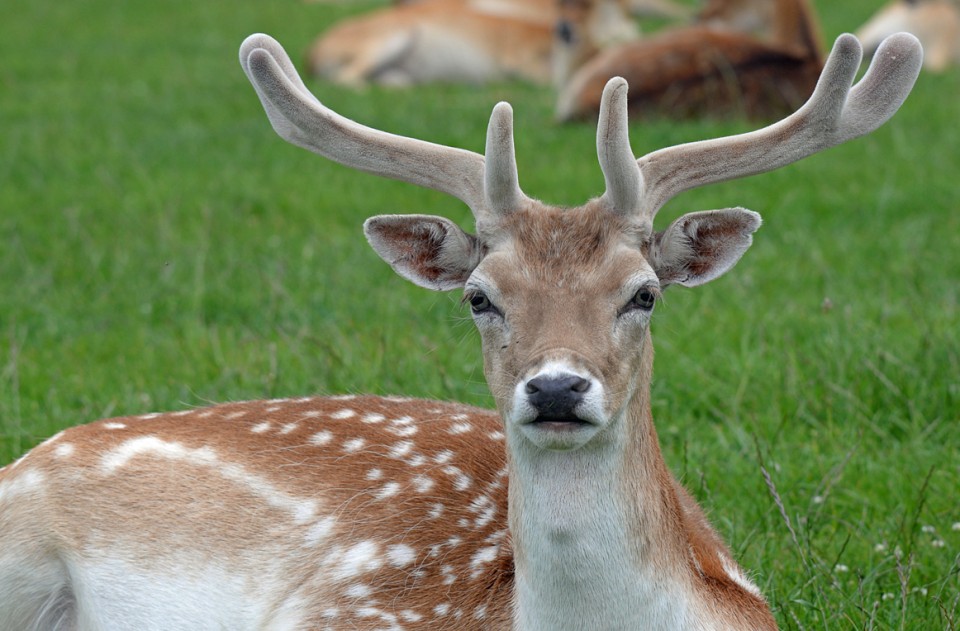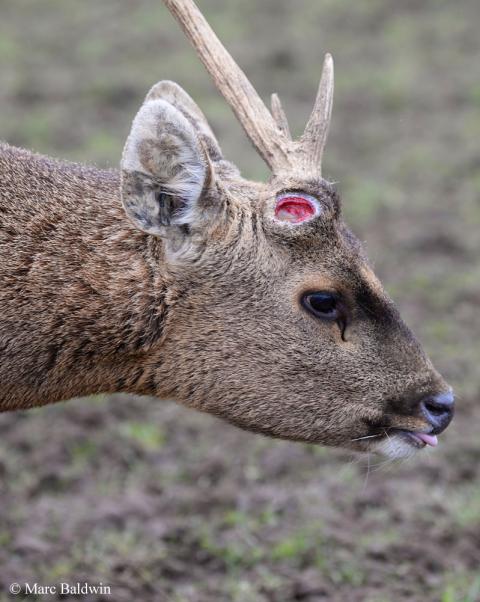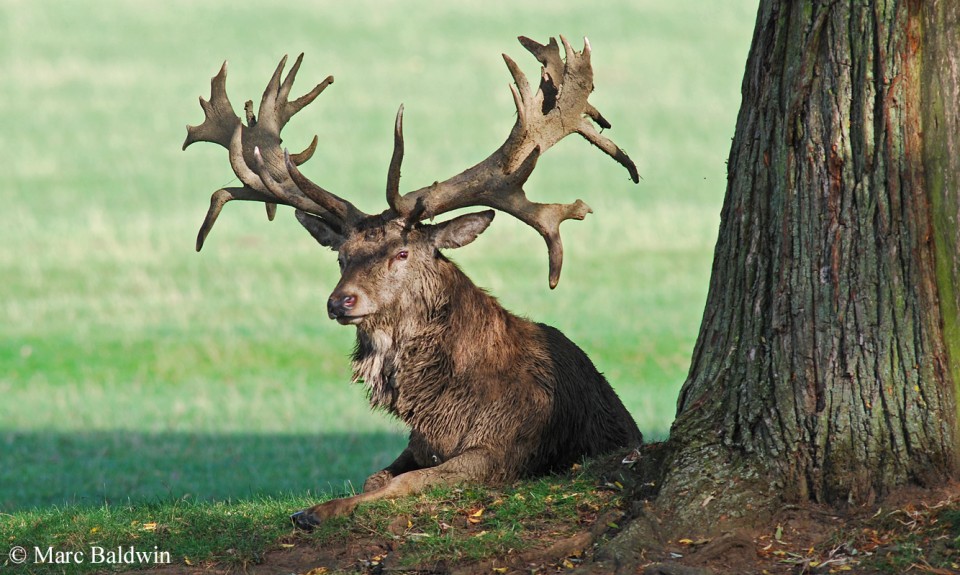Deer (Overview) - Antler Development Summary
Unlike horns, which are permanent structures, antlers are shed and re-grown each year. Some deer begin growing their new antlers almost immediately after the old ones have been shed, while others may exhibit a delay between shedding and re-growth.
Horns consist of a bony projection of the frontal (forehead) bone enclosed by a sleeve of keratin – they maintain a venous (blood) and nervous supply that allows keratin to be deposited (and hence the horn to grow) throughout the animal’s lifetime. Antlers, by contrast, are made of bone and develop from a point on the top of the skull called the pedicle, rather than from the skull itself. The antler grows out of the pedicles and, during its formation, is covered with hairy skin called velvet that’s pinky-grey in colour and packed with blood vessels and nerves, making them highly sensitive to the touch – a stag in velvet is still sometimes referred to by the 16th Century term “pollard”. So critical is the blood flow supplied by the velvet that should it get damaged, the antlers can become deformed. The potential rejuvenating power of deer velvet has led to the marketing of tablets made from the velvet of farmed deer; the tablets are said to provide relief from various ailments spanning impotence to arthritis, whilst also having immune enhancing properties.

When the antler’s growth is complete, the velvet dries up and is shed – at this point, the deer is said to be “in tatters”. The shedding process appears to be under hormonal control and usually takes less than 24 hours. Deer antlers have androgen (male sex hormones) receptors and it appears that an increase in circulating testosterone (probably related to increasing day length) triggers the blood supply to be severed and the velvet to die and dry out. When the antlers have been cleaned by the stag or buck (i.e. the velvet has been completely removed), the animal is said to be in the misnomer of “hard horn”. There is some recent data to suggest that the antler retains a vascular connection that helps keep it moist, which is an important factor in their strength in combat, but cleaned antlers are generally considered “dead bone” as the nerve supply has been terminated and the blood supply is insufficient to repair the antler should damage occur. In her 1991 book Deer, biologist Norma Chapman explains that the basic antler pattern is genetically-fixed for a species, although the exact form and size of the antlers are affected both by parental characters and quality of food.
A study conducted by Uwe and Horst Kierdorf at the University of Giessen in Germany found that Roe deer antlers form by a different process to those of either Red or Fallow. In Red and Fallow deer a cartilage ‘model’ is built that is then turned to bone, a process called modified endochondral ossification, while in Roe deer it’s the connective tissue membrane that’s turned to bone in a process known as intramembraneous ossification. Despite the framework formation of Roe antlers being different, the antler growth proceeds by endochordal ossification in all three species.

In most species, casting of antlers is initiated by a drop in blood testosterone. Many studies on captive deer have demonstrated that if a stag is castrated while in full antler (i.e. hard horn), it will still cast and re-grow antlers, but the velvet will never dry out and the antlers will not be shed. Under normal circumstances, antlers are shed and re-grown annually to coincide with the deer’s breeding season. Red, Fallow and Sika shed their antlers during April and May and the new growth is complete and cleaned by August/September. Roe, which breed earlier, shed their antlers in November/December and re-grow them over the winter and early spring such that they’re cleaned during April/May. Reeves' muntjac appear to be a special case, having “decoupled” their antler and reproductive cycles. Several authors note that muntjac bucks shed their antlers during April or May, but this seems highly variable and I have observed bucks in velvet during March and with new antler buds in early June - they can breed at any time of the year. Reindeer are unique in two respects: females routinely grow antlers; and, like muntjac, their antler cycle appears unconnected to hormone levels. Mature bull reindeer cast antlers during November, immature males and non-pregnant cows tend to cast during February, while pregnant females won’t cast until May, shortly after giving birth.
Antlers represent a huge mineral source, including calcium, phosphorous, sulphur, magnesium and potassium. These are valuable minerals in many woodland ecosystems and, consequently, when they're shed they tend to be eaten by deer and other animals, particularly mice and squirrels. This explains why we're not knee-deep in antlers every spring and also why it is best not to collect antlers if you find them in the forest. The antler itself is composed of various types of structural cells and there is an apparent negative correlation between calcium content and fat concentration along the antler – calcium levels increase towards the base of the antler, whilst lipid concentrations are highest at the tip - which helps explain why certain parts may be targeted more than others by scavengers. The velvet contains various amino acids including all eight essential ones (i.e. those that are required in the diet and can’t be synthesized by the animal) and may also be eaten.
Deformities can arise through two main channels: interference of sex hormones through damage to the testicles, or damage either to the growing antler or the frontal (skull) bone from which the pedicle grows. The resulting antlers may be stunted or lop-sided and may fail to cast properly, if at all. Mild trauma may be reconciled in subsequent years, while more serious damage may leave a permanent deformity. If the frontal bone is damaged, it can prevent antler growth entirely.
For decades scientists have debated the function of deer antlers. The most widely accepted theory is that antlers evolved as weapons where deer compete for resources; predominantly, although not limited to, mates. In the first instance antlers are an indicatior of fitness – they require a considerable amount of energetic and nutritional expenditure to produce and a large antler set typically reflects an animal in good condition, although there’s an element of genetic control and habitat quality involved too. They can also be used by would-be interlopers to assess their chances in a fight and are used as physical weapons to both repel an attack from, and initiate a challenge to, a contender. Recent studies on moose in Europe have suggested that the antlers may also act as parabolic reflectors of sound, so moose with antlers have more sensitive hearing than those without. Logically, other species with palmate antlers (e.g. Fallow) may also gain a similar advantage.

Recent data on the genomic analysis of antler and horn development among deer and bovids (cows, sheep, goats, antelope, etc.) found many of the same genes involved in the formation of both structures, implying a common ancestry. Furthermore, some of the genes involved in antler growth are the same ones that cause cancers in mammals, such that antlers appear to essentially by a controlled form of bone cancer. Deer appear to have a very active collection of anti-tumour genes that help keep this rapid growth process in check, however, and this probably helps explain why they also seem less prone to suffering with cancers than other mammals.
For a more comprehensive overview of how antlers form and what function they serve, the reader is directed to the antler Q/A.